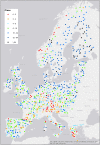Assessing Compliance of European Fresh Waters for Copper: Accounting for Bioavailability
- PMID: 30578437
- PMCID: PMC6394535
- DOI: 10.1007/s00128-018-2515-1
Assessing Compliance of European Fresh Waters for Copper: Accounting for Bioavailability
Abstract
This study determines the levels of compliance of European fresh waters with a bioavailability-based copper Environmental Quality Standard (EQS). A tiered approach for compliance assessment is used at which the first tier compares the dissolved metal concentration to a threshold, estimated using either regional or continental water chemistry data. At the second tier, the bioavailable metal concentration is calculated using the chemistry of the water body, and compared to the EQSbioavailable for copper. The thresholds at Tier 1 must be set at a level to ensure adequate protection of sensitive environments and to ensure efficient use of regulatory resources. Compliance of 99.3% is observed where bioavailability-based thresholds are used for the implementation derived from regionally relevant water chemistry data. Sites where elevated ambient background levels of copper are combined with high bioavailability (waters with low dissolved organic carbon) are those most likely to be at risk from copper exposures.
Keywords: Bioavailability; Compliance assessment; Copper; Environmental quality standard; Water framework directive.
Figures
References
-
- Baken S, Cooper C, Van Assche F, Schlekat C, Chowdhury J, Bortoluzzi A, Stubblefield B, Vercaigne I, Verdonck F (2017) BIO-MET v4.0—a tool for metal bioavailability under the EU Water Framework Directive, SETAC Europe conference 2017, Brussels, May
-
- Crane M, Fisher B, Leake C, Nathail P, Peters A, Stubblefield W, Warn T. Derivation and use of environmental quality and human health standards for chemical substances in water and soil. Boca Raton: SETAC CRC Press; 2010. How should an environmental standard be implemented. Chapter; p. 140.
MeSH terms
Substances
LinkOut - more resources
Full Text Sources


